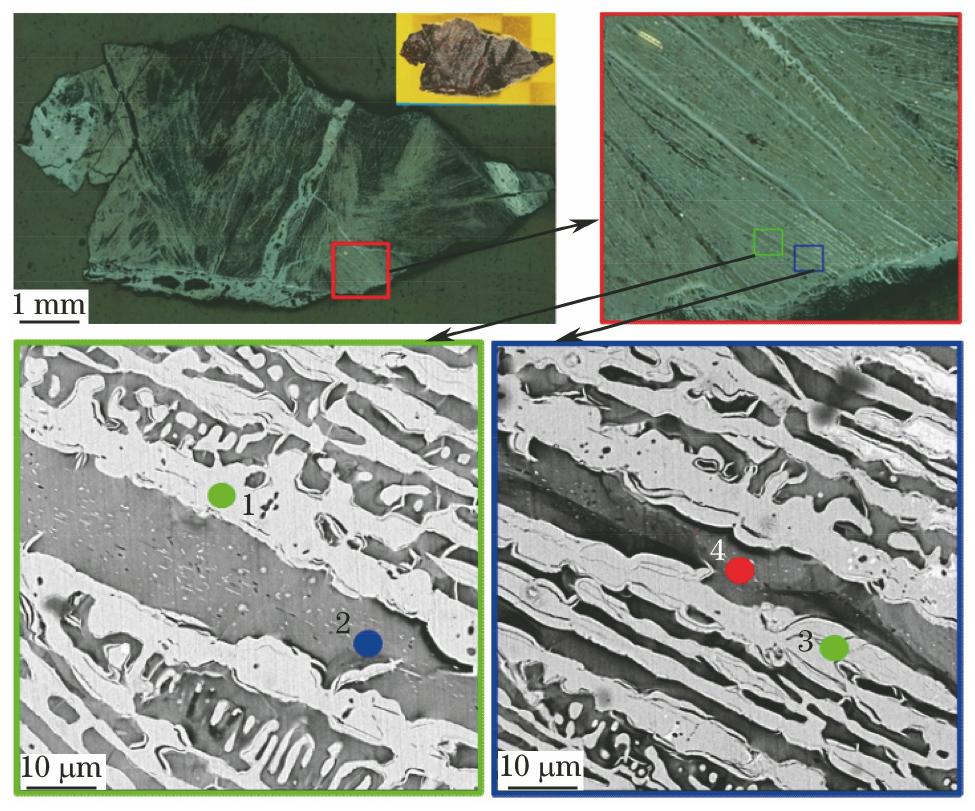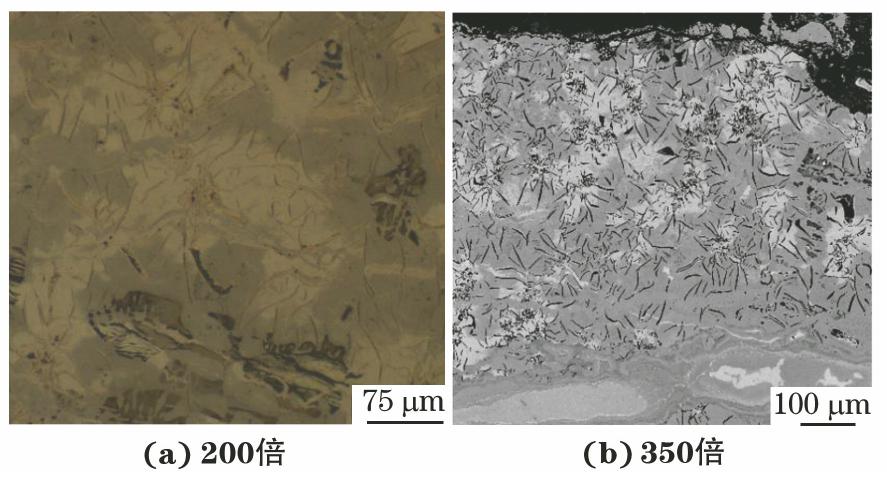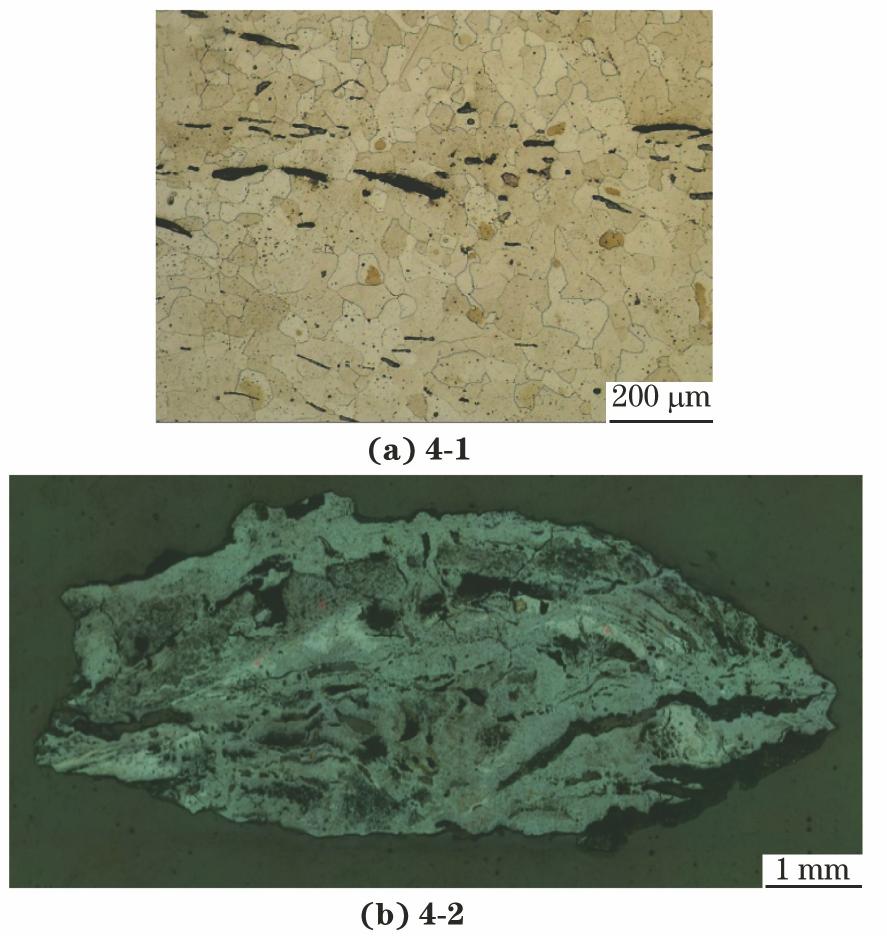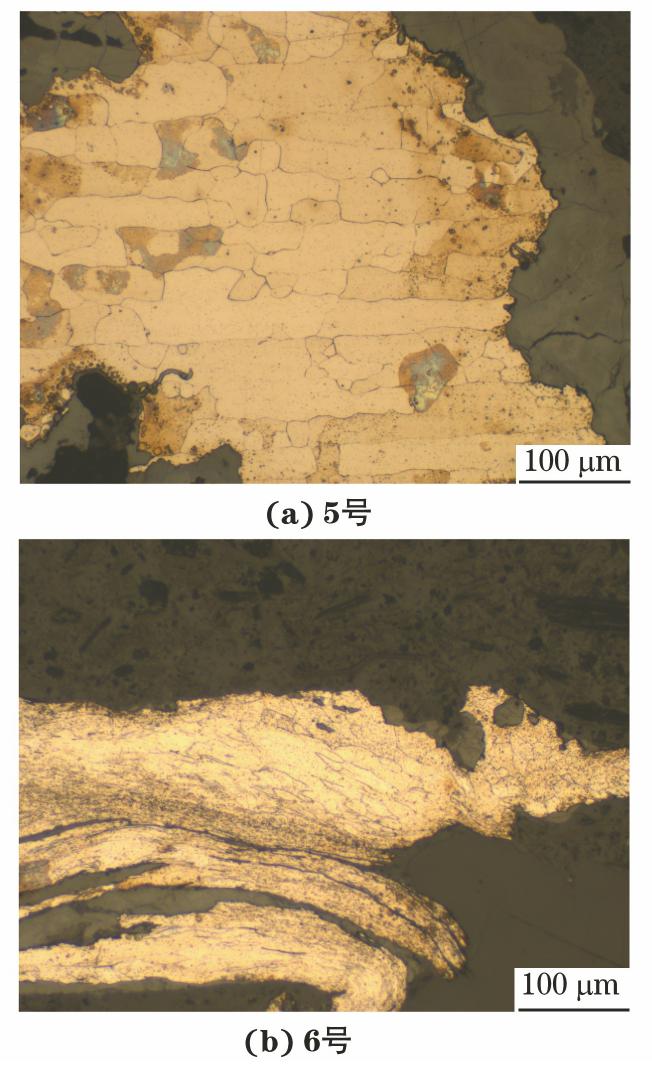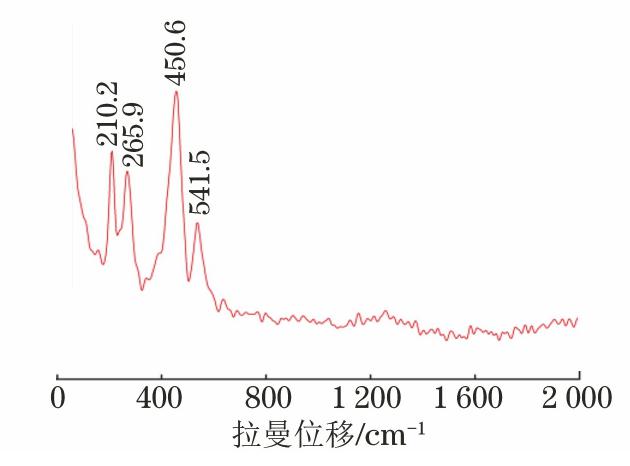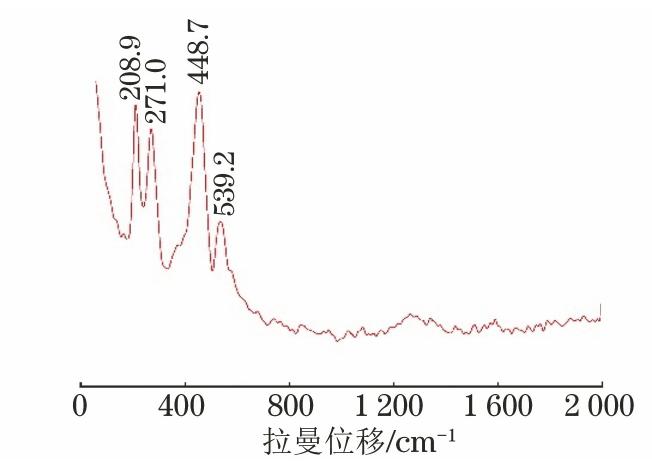In-Situ Analysis of the Rust Morphology of Unearthed Iron Relics and Its Mechanism
-
摘要:
利用超景深显微镜、金相显微镜、扫描电子显微镜、能谱仪、显微拉曼光谱仪等,对六件湖北地区出土铁质文物的锈蚀状况进行了原位分析,以深入研究铁质文物不同锈蚀形态。结果表明,铁质文物的锈蚀形态可分两类:(1)一般铸铁器物的原始形态清晰可辨,其锈层有组织“痕像”残存,其锈蚀产物为铁的氧化物和C;(2)一般熟铁器物的原始形态被锈层破坏,其锈层中无组织“痕像”,其锈蚀产物通常包括α-FeOOH、Fe3O4、α-Fe2O3、β-FeOOH等。铸铁中大量渗碳体和石墨的存在是锈层中残存“痕像”组织,并保持器物原始形态的重要原因。Ⅰ型锈一般保留器物原始形态特征,若为无害锈则予以保留;Ⅱ型锈往往破坏了器物原始表面,导致纹饰器型难辩,即使为无害锈也需适当去除。
Abstract:In situ analysis was conducted on the corrosion status of six iron cultural relics unearthed in Hubei Province using a super depth microscopy, metallographic microscopy, scanning electron microscopy energy spectrometer, and micro Raman spectrometer, in order to further study the different corrosion forms of iron cultural relics. The results show that the corrosion forms of iron artifacts could be divided into two categories. (1) The original form of general cast iron objects was clear and distinguishable, and the rust layer had organized "scar like" remnants, and the corrosion products were iron oxides and C. (2) The original form of general wrought iron was destroyed by the rust layer, and there were no organized “traces” in the rust layer. The rust products included α-FeOOH, Fe3O4, α-Fe2O3, β-FeOOH, etc. The presence of a large amount of carbides and graphite in cast iron was an important reason for the residual “trace like” structure in the rust layer and the preservation of the original shape of the object. Type I rust generally retains the original morphological characteristics of the object, and if it is harmless rust, it is preserved. Type II rust often damages the original surface of the object, making it difficult to distinguish the decorative pattern, harmless rust also should be removed appropriately.
-
Keywords:
- iron relic /
- rust morphology /
- in-situ analysis
-
铁器时代对整个世界的农业和人口分布、经济和政治发展产生了重要的影响。铁质文物由于本身的化学性质不稳定,极易发生腐蚀,难以保存。因此,为提供合理科学的保护方法,锈蚀产物的研究显得尤为重要。铁器的腐蚀因素分为内因和外因,内因是文物本身的物理化学性质、加工工艺、显微组织等,外因是铁器的埋藏与保存环境[1]。
目前,对于铁器锈蚀物的研究主要集中于铁器的锈蚀物及环境作用下铁器的腐蚀行为。王蕙贞等[1]从化学腐蚀、电化学腐蚀、制作工艺和保存环境等方面探讨了陕西出土的秦汉铁器锈蚀物的成因。王淡春等[2]研究了郑韩故城出土的战国晚期铁器的锈蚀机理,锈蚀物稳定性与制作工艺的关系等。许淳淳等[3]将仿古铸铁置于模拟土壤介质中,对其腐蚀形态、腐蚀产物微观形貌及其生长和发展规律进行研究。王智慧[4]对模拟大气环境中铸铁的腐蚀行为进行探讨。ROBBIOLA等[5]根据青铜器锈蚀产物的结构,将其分为两类:Ⅰ型锈蚀表面是光滑而密集的,锈蚀物从表面向内部生长,其显著特点是保留了器物的原始表面以及清晰的抛光和使用痕迹;Ⅱ型锈蚀表面粗糙,形态复杂,包括坑状、斑状、淋巴状等,腐蚀界面的体积变化较大。此次研究的湖北地区出土的铁质文物,有些器物的表面形貌特征清晰可辨,锈蚀后表面的棱角、范线、纹饰等形貌无明显变化,锈蚀致密,类似青铜器的Ⅰ型锈,而有些器物表面则存在凸出的粗大锈体,类似青铜器的Ⅱ型锈。
笔者通过对湖北地区出土的六件铁器本体进行形貌观察,并采用超景深显微镜、光学显微镜(OM)、拉曼光谱仪、扫描电子显微镜(SEM)及能谱仪(EDS)等对器物的宏观形态、微观组织形貌结构、锈蚀产物化学成分与物相结构等进行系统分析,以期揭示铁器锈蚀物的宏观物理形态与内部结构的关系,为铁器文物的保护修复工作及考古学研究提供重要的参考依据。
1. 试验
1.1 试样
选取湖北地区出土的六件铁器,年代为战国至西汉,器物种类为食器和工具,基本信息见表1。由表1可见:1号和2号铁器足部的纹饰轮廓、棱线特征及形态仍清晰可辨。3号铁器因腐蚀严重,出土后尚未整理,无法进行拍照,仅进行了X射线探伤检测,X射线探伤检测结果表明,其口沿、圈足原始形态依然保持。上述三件器物的锈层致密,器物基本保持了原有形态,应属Ⅰ型锈。4号铁器表面锈层疏松、起伏较大,器型难以辨认。5号铁器锈层疏松,锈层表面凹凸不平,改变了器物原有的平整度。6号铁器锈层疏松,锈蚀产物高于原有器表,器型发生变化。上述三件器物的锈层疏松,器物原有形态发生改变,应属Ⅱ型锈。
表 1 铁器的基本信息Table 1. Basic information of irons序号 器物名称 锈蚀特征 收藏单位 年代 来源 尺寸/cm 1 铁足铜鼎 锈层致密,足部棱线、纹饰轮廓特征可辨 襄州区博物馆 秦 张岗荒坡松树林墓地 高22.5,口沿19 2 铁足铜鼎 锈层致密,足部棱线、形态特征可辨 襄州区博物馆 战国 出土地不明 高27,口径22,腹径25 3 铁釜 圈足与口沿部位的原始形态基本维持 随州市博物馆 西汉 周家寨墓地 — 4 铁斧 锈层疏松,呈粗大凸起状,锈层发生剥离 湖北省博物馆 战国 襄阳欧庙遗址 长14,宽11,高4 5 铁锸 锈层疏松,锈层表面凹凸不平 湖北省博物馆 战国 江陵纪南城南 长9.6,宽10.2 6 铁钁 锈层疏松,锈层表面凹凸不平,器形轮廓模糊 湖北省博物馆 战国 江陵纪南城南 长6.8,宽2~4.6 为了最大限度地保护文物,从器物断裂边缘或脱落残片取样,共计七个,其中4-1和4-2均为4号铁器的样品,详见表2。
表 2 检测样品的基本情况Table 2. Basic information of samples样品编号 器物名称 取样部位 器物类别 1 铁足铜鼎 右前足残片 食器 2 铁足铜鼎 铁足残片 食器 3 铁釜 口沿处 食器 4-1 铁斧 銎部 工具 4-2 剥离残片 5 铁锸 锸首断裂处 工具 6 铁钁 钁柄断裂处 工具 1.2 试验方法
1.2.1 显微组织观察
将采集的样品制成金相试样,使用德国徕卡DVM6型超景深显微镜,在明场和暗场条件下观察锈层试样显微结构。对于金属基体试样,抛光后使用浸蚀液(体积分数为4%的硝酸乙醇溶液)处理,使用德国Leica DM2700型金相显微镜对其进行金相观察。
1.2.2 成分分析
使用荷兰Phenom XL型台式扫描电镜及其配套的能谱仪对试样各组织的形貌及合金成分进行原位检测,以判断锈蚀物成分。加速电压为15 kV。
1.2.3 锈蚀产物分析
使用法国HORIBA XploRA plus型拉曼光谱仪对锈蚀物进行原位检测,以判断锈蚀物的物相结构。激光器波长为532 nm。
2. 结果与讨论
2.1 显微组织
七件试样中,除4-1、5和6号试样的金属基体尚存,其余四件均完全锈蚀,检测结果见图1~5,试样组织观察结果见表3。
表 3 试样的组织观察结果Table 3. Metallographic structure observation results of samples试样编号 器物名称 组织观察结果 材质 1 铁足铜鼎 珠光体、莱氏体和二次渗碳体组织,组织均匀,亚共晶组织 白口铸铁 2 铁足铜鼎 莱氏体和一次渗碳体组成,组织均匀,过共晶组织 白口铸铁 3 铁釜 大量片状和菊花状石墨分布于以珠光体为主的基体上,存在少量的莱氏体,灰口铁组织 灰口铸铁 4-1 铁斧 铁素体组织,晶粒细碎夹杂物沿加工方向拉长,夹杂物较多 熟铁 4-2 无法辨认组织 5 铁锸 铁素体组织,夹杂物沿加工方向变形拉长,夹杂物较多 熟铁 6 铁钁 铁素体组织,夹杂物沿加工方向变形拉长,形变量不一 熟铁 2.2 锈蚀产物分析
使用拉曼光谱对六件器物的锈蚀产物进行检测。其中,对于1号和2号试样,结合显微组织观察中的选点进行原位检测,其余试样因无法分辨锈蚀物的组织特征,故在锈层上选点检测,拉曼光谱见图6~11,锈层分析结果见表4。
表 4 锈蚀层分析结果Table 4. Analysis results of rust layer样品编号 器物名称 组织 拉曼光谱分析结果 1 铁足铜鼎 白口铸铁,亚共晶白口铁组织,由珠光体、莱氏体和二次渗碳体组成 α-FeOOH+C、C 2 铁足铜鼎 白口铸铁,过共晶白口铁组织,由莱氏体和一次渗碳体组成 α-FeOOH+C、C 3 铁釜 灰口铸铁,大量片状和菊花状石墨分布于以珠光体为主的基体上,存在少量的莱氏体 γ-FeOOH、α-Fe2O3+C、FeO(OH)·nH2O、Fe(OH)3 4-1 铁斧 熟铁,铁素体组织 α-FeOOH、Fe3O4、α-Fe2O3、β-FeOOH 4-2 熟铁(4号铁斧矿化样) 5 铁锸 熟铁,铁素体组织 α-Fe2O3 6 铁钁 熟铁,铁素体组织 α-Fe2O3 由表5可见:1号试样显微组织是由珠光体和渗碳体组成的莱氏体组织,其中的亮色圆形斑点为珠光体,经检测:点1、2为未腐蚀的金属颗粒,主要成分为Fe和C,而点3、4、5、6中的O含量较高,推测其为Fe的腐蚀产物。2号试样亮色长条形部分的点1、2处组织为未腐蚀完全的渗碳体,其中含C,珠光体组织中的点3、4为Fe的氧化腐蚀产物。上述结果说明保留组织“痕像”的1号和2号试样各组织存在优先腐蚀。
表 5 部分器物样品扫描电镜能谱分析结果Table 5. SEM-EDS results of some iron samples
2.3 讨论
铁器锈蚀状况不仅与保存环境有关,还与其内部组织存在密切关系。从宏观形态上看,由于Ⅰ型锈锈层自器物原始表面向内生长,因此器形轮廓特征清晰可辨,而Ⅱ型锈锈层在生长中除向内生长外,还向外发展,会破坏器物原始表面,因此其形态难以辨认。显微分析表明,Ⅰ型锈器物锈层中保留了组织“痕像”,且均为铸铁组织。而Ⅱ型锈器物锈层无组织保留,为熟铁。Ⅰ型锈器物中(1号和2号试样)除自身的一次渗碳体、二次渗碳体组织外,珠光体、莱氏体组织中也含有渗碳体。珠光体组织是铁素体与渗碳体组成的混合物,莱氏体组织是共晶奥氏体与共晶渗碳体组成的混合物[6]。3号试样中C以石墨形式存在、基体以珠光体为主并存在少量的莱氏体。而Ⅱ型锈器物组织仅为铁素体单相晶粒,无渗碳体组织及石墨分布。综上可知,铁器锈蚀特征与碳含量有关,组织中的碳含量越高,残留的渗碳体组织、石墨越多。渗碳体组织及石墨可能是白口铸铁、灰口铸铁器物锈层向内生长,并保留组织“痕像”的重要因素。
渗碳体是间隙固溶体,碳的质量分数为6.69%,Fe-C键具有金属键和共价键,其结合强度是Fe-Fe键的两倍,原子间具有强结合力,硬度高[6]。1号和2号试样锈层中的鱼骨状、枝晶状渗碳体组织及莱氏体、珠光体中以球状、层状分布的渗碳体组织遍布整个结构。拉曼光谱原位分析结果表明,这两件试样的锈蚀产物中,渗碳体的腐蚀产物为C,珠光体的腐蚀产物为α-FeOOH+C。因珠光体由铁素体和渗碳体组成,可以推测,铁素体的腐蚀产物为铁的氧化物(α-FeOOH)。在渗碳体的腐蚀产物中仅检测到C,推测其腐蚀产物中铁氧化物以非晶体的形式存在。在以往青铜器[7]和铁器[8]的研究中,均发现了无定形锈蚀产物。因此,白口铸铁中的渗碳体在锈蚀过程中,能以原始形态保留在组织中。3号试样(灰口铁)中的石墨三维网状结构不会随器物的腐蚀而消失,同样也能以原始形态保留其中,使铸铁文物保持原有的形貌[9]。
铁器各组织在埋藏环境中,均可发生局部电化学腐蚀,且随着碳含量的逐渐增多,不同组织极性依次为:石墨>渗碳体>莱氏体>珠光体>铁素体,由于各组织活性不同,会产生优先腐蚀现象。亚共晶白口铁(1号样)组织中,珠光体相对于莱氏体发生优先腐蚀。过共晶白口铁(2号样)组织中莱氏体相对渗碳体,发生优先腐蚀。当铁素体与渗碳体并存时,白口铸铁组织中会形成许多微电池,铁素体为阳极、渗碳体为阴极,铁素体优先发生腐蚀。灰口铁(3号试样)为石墨化腐蚀,石墨在多数腐蚀介质中不发生反应且其极性最大,珠光体与莱氏体基体发生选择性腐蚀,最后残留大量的石墨结构[10]。研究发现申明铺遗址出土铁器[11]的莱氏体组织中圆颗粒状的珠光体组织易发生锈蚀。王紫色等[12]研究发现,随渗碳体含量的减少,铁器腐蚀加剧。
在铸铁器物中,白口铁中的渗碳体在整个组织中形成密集网状结构,而渗碳体后于铁素体腐蚀,故铁素体晶粒在优先腐蚀过程中,被禁锢在渗碳体网状结构中。渗碳体的腐蚀产物为无定形铁的氧化物和C,也能保持原始组织形态,故白口铸铁器物腐蚀后,器物的宏观形态特征未发生明显改变。铸铁在石墨化腐蚀过程中,网状石墨结构和腐蚀产物形成表面层,其具有牢固且致密的特性,尤其是基体呈细密的珠光体和连续性好的片状石墨组织的灰口铁更易形成致密的表面膜,因此能维持器物表面原有的形态特征[10]。这类似青铜器中的I型锈。
熟铁器物中的铁素体组织,C溶于α-Fe的间隙固溶体,为体心立方结构,组织中只有单相晶粒,未能形成渗碳体网状结构和石墨。Fe在腐蚀过程中,转变为α-FeOOH、Fe3O4、α-Fe2O3、β-FeOOH等氧化物晶体,会突破原有Fe原子的晶格,沿晶体取向生长,从而破坏原有器物表面,形成表面疏松、膨胀的锈层,类似青铜器中的II型锈。本工作中4~6号试样的组织均为单相的铁素体晶粒。
除本工作中1~3号器物锈蚀特征属于I型锈之外,在已有的研究中也有I型锈特征的器物。汉阳陵出土的铁器[13]中,德赛M107:10铁盆和铁釜-3材质均为灰口铁,铜绿山遗址[14]出土的大铁锤的材质为灰口铁。西安古桥遗址出土的两件大型铸铁件[15]的材质分别为白口铁和灰口铁。
针对不同锈蚀形态的铁质文物保护,I型锈保留了器物原始表面、器型特征,一般予以保留;II型锈可能破坏了器物的原始表面,导致纹饰消失、器型难以辨认,即使是无害锈,在必要的情况下,也应予以适当去除,以恢复器物外形。
3. 结论
(1)铁器的腐蚀产物从宏观形貌上,可分为两类。一类是可以保留器物原始表面的锈蚀物,特征为器物表面的棱线、范缝、纹饰都清晰可辨,类似青铜器中的I型锈。另一类锈层呈疏松状,相当于青铜器中的II型锈,具有这类锈层的器物宏观表现为棱角、纹饰等细节被锈层覆盖、器物的原始表面遭到破坏,且锈层膨胀疏松,严重时会导致器形难以辨认。
(2)I型锈器物锈层中保留了基体组织“痕像”,珠光体、莱氏体组织和石墨清晰可辨;II型锈的器物腐蚀后其组织已无法识别。I型锈检测结果往往以铁氧化结晶物和C为主,渗碳体锈蚀产物为C,Fe可能以非晶态的形式存在;II型锈往往形成结晶态的铁氧化物。
(3)一般铸铁器物表面锈层为I型锈,由于其为多相组织,铁素体发生优先腐蚀,白口铁组织中大量密集且具有强结合力的渗碳体,使铁素体锈蚀向内发展且渗碳体腐蚀后形貌不发生改变,进而维持了器物原有的形态。灰口铁组织中保留的三维网状石墨与腐蚀产物形成致密层保持了器物原来的形貌特征。一般熟铁器物为II型锈,单相的铁素体晶粒间无渗碳体组织和石墨,铁氧化结晶物沿晶体取向生长,导致宏观器物形貌发生变化。
(4)在对不同锈蚀形态的铁质文物进行保护时,I型锈保留器物原始表面、器型特征,若为无害锈则一般予以保留;II型锈可能破坏了器物的原始表面,为恢复其器型特征,即使是无害锈,在必要的情况下,也应予以适当去除。
-
表 1 铁器的基本信息
Table 1 Basic information of irons
序号 器物名称 锈蚀特征 收藏单位 年代 来源 尺寸/cm 1 铁足铜鼎 锈层致密,足部棱线、纹饰轮廓特征可辨 襄州区博物馆 秦 张岗荒坡松树林墓地 高22.5,口沿19 2 铁足铜鼎 锈层致密,足部棱线、形态特征可辨 襄州区博物馆 战国 出土地不明 高27,口径22,腹径25 3 铁釜 圈足与口沿部位的原始形态基本维持 随州市博物馆 西汉 周家寨墓地 — 4 铁斧 锈层疏松,呈粗大凸起状,锈层发生剥离 湖北省博物馆 战国 襄阳欧庙遗址 长14,宽11,高4 5 铁锸 锈层疏松,锈层表面凹凸不平 湖北省博物馆 战国 江陵纪南城南 长9.6,宽10.2 6 铁钁 锈层疏松,锈层表面凹凸不平,器形轮廓模糊 湖北省博物馆 战国 江陵纪南城南 长6.8,宽2~4.6 表 2 检测样品的基本情况
Table 2 Basic information of samples
样品编号 器物名称 取样部位 器物类别 1 铁足铜鼎 右前足残片 食器 2 铁足铜鼎 铁足残片 食器 3 铁釜 口沿处 食器 4-1 铁斧 銎部 工具 4-2 剥离残片 5 铁锸 锸首断裂处 工具 6 铁钁 钁柄断裂处 工具 表 3 试样的组织观察结果
Table 3 Metallographic structure observation results of samples
试样编号 器物名称 组织观察结果 材质 1 铁足铜鼎 珠光体、莱氏体和二次渗碳体组织,组织均匀,亚共晶组织 白口铸铁 2 铁足铜鼎 莱氏体和一次渗碳体组成,组织均匀,过共晶组织 白口铸铁 3 铁釜 大量片状和菊花状石墨分布于以珠光体为主的基体上,存在少量的莱氏体,灰口铁组织 灰口铸铁 4-1 铁斧 铁素体组织,晶粒细碎夹杂物沿加工方向拉长,夹杂物较多 熟铁 4-2 无法辨认组织 5 铁锸 铁素体组织,夹杂物沿加工方向变形拉长,夹杂物较多 熟铁 6 铁钁 铁素体组织,夹杂物沿加工方向变形拉长,形变量不一 熟铁 表 4 锈蚀层分析结果
Table 4 Analysis results of rust layer
样品编号 器物名称 组织 拉曼光谱分析结果 1 铁足铜鼎 白口铸铁,亚共晶白口铁组织,由珠光体、莱氏体和二次渗碳体组成 α-FeOOH+C、C 2 铁足铜鼎 白口铸铁,过共晶白口铁组织,由莱氏体和一次渗碳体组成 α-FeOOH+C、C 3 铁釜 灰口铸铁,大量片状和菊花状石墨分布于以珠光体为主的基体上,存在少量的莱氏体 γ-FeOOH、α-Fe2O3+C、FeO(OH)·nH2O、Fe(OH)3 4-1 铁斧 熟铁,铁素体组织 α-FeOOH、Fe3O4、α-Fe2O3、β-FeOOH 4-2 熟铁(4号铁斧矿化样) 5 铁锸 熟铁,铁素体组织 α-Fe2O3 6 铁钁 熟铁,铁素体组织 α-Fe2O3 表 5 部分器物样品扫描电镜能谱分析结果
Table 5 SEM-EDS results of some iron samples

-
[1] 王蕙贞, 朱虹, 宋迪生, 等. 秦汉铁器锈蚀机理探讨及保护方法研究 [J]. 文物保护与考古科学, 2003, 15(1):7-11. WANG H Z, ZHU H, SONG D S, et al. Study on the corrosion mechanism and the protection methods of iron objects in Qin and Han Dynasties [J]. Sciences of Conservation and Archaeology, 2003, 15(1):7-11.
[2] 王淡春, 罗武干, 蔡全法, 等. 郑韩故城出土战国晚期铁器腐蚀产物分析 [J]. 文物保护与考古科学, 2018, 30(6):48-52. WANG D C, LUO W G, CAI Q F, et al. Analysis of the corrosion products of the late Warring States Period iron wares unearthed from the City Site of Zheng and Han States [J]. Sciences of Conservation and Archaeology, 2018, 30(6):48-52.
[3] 许淳淳, 王紫色, 王菊琳. 模拟土壤介质中仿古铸铁腐蚀产物的形貌及其生长过程 [J]. 化工学报, 2005, 56(12):2373-2379. XU C C, WANG Z S, WANG J L. Appearance and formation process of corrosion products on archaeological iron in simulated soil media [J]. CIESC Journal, 2005, 56(12):2373-2379.
[4] 王智慧模拟大气环境下铁器腐蚀行为及缓蚀材料性能研究北京北京化工大学2021王智慧. 模拟大气环境下铁器腐蚀行为及缓蚀材料性能研究 [D]. 北京: 北京化工大学, 2021. WANG Z HStudy on corrosion behavior of iron and performance of corrosion inhibitor in simulated atmospheric environmentBeijingBeijing University of Chemical Technology2021WANG Z H. Study on corrosion behavior of iron and performance of corrosion inhibitor in simulated atmospheric environment [D]. Beijing: Beijing University of Chemical Technology, 2021.
[5] ROBBIOLA L, BLENGINO J M, FIAUD C. Morphology and mechanisms of formation of natural patinas on archaeological Cu - Sn alloys [J]. Corrosion Science, 1998, 40(12):2083-2111. [6] 李炯辉, 林德成. 《金属材料金相图谱》上册 [M]. 北京: 机械工业出版社, 2006. [7] 成小林, 潘路. 新干商墓青铜器非晶与纳米晶锈蚀产物结构的分析研究 [J]. 光谱学与光谱分析, 2012, 32(5):1270-1273. CHENG X L, PAN L. Research on the mineral phase and component of non-crystalline and nano-crystalline corrosion products on bronzes unearthed from Shang tomb in Xingan [J]. Spectroscopy and Spectral Analysis, 2012, 32(5):1270-1273.
[8] 张恒金, 郭殿勇. 出土铁器的结构、组成及劣化机理 [J]. 内蒙古文物考古, 1994(1):129-132. [9] GIL M L A, SANTOS A, BETHENCOURT M, et al. Use of X-ray and other techniques to analyse the phase transformation induced in archaeological cast iron after its stabilisation by the electrolytic method [J]. Analytica Chimica Acta, 2003, 494(1/2):245-254. [10] 申泽骥, 苏贵桥. 铸铁的电化学腐蚀机理 [J]. 现代铸铁, 2002, 22(1):13-16. SHEN Z J, SU G Q. Corrosion mechanism of electro-chemical erosion of cast iron [J]. Modern Cast Iron, 2002, 22(1):13-16.
[11] 戎岩. 申明铺遗址出土腐蚀铁器的微观分析 [J]. 咸阳师范学院学报, 2012, 27(4):87-90. RONG Y. Microscopic analysis of corrosion of iron relics unearthed from Shenmingpu site [J]. Journal of Xianyang Normal University, 2012, 27(4):87-90.
[12] 王紫色, 许淳淳, 杨曼学. 4种不同金相组织的仿古铸铁在土壤中局部腐蚀行为的差异 [J]. 铸造技术, 2007, 28(7):968-973. WANG Z S, XU C C, YANG M X. Difference of local corrosion behaviors of archaeological cast irons with four different microstructures in soil [J]. Foundry Technology, 2007, 28(7):968-973.
[13] 张昕瑞汉阳陵出土铁器制作工艺与保存现状研究西安西北大学2018张昕瑞. 汉阳陵出土铁器制作工艺与保存现状研究 [D]. 西安: 西北大学, 2018. ZHANG X RResearch on the manufacturing technology and preservation status of ironware unearthed from Hanyang MausoleumXi'anNorthwest University2018ZHANG X R. Research on the manufacturing technology and preservation status of ironware unearthed from Hanyang Mausoleum [D]. Xi'an: Northwest University, 2018.
[14] 冶军. 铜绿山古矿井遗址出土铁制及铜制工具的初步鉴定 [J]. 文物, 1975(2):19-25,99-100. [15] 石晶晶, 赵凤燕, 李秀辉. 西安古桥遗址出土汉代大型铸铁件的分析研究 [J]. 文博, 2019(6):91-97. SHI J J, ZHAO F Y, LI X H. Analysis of the large Han period cast iron objects discovered at the ancient bridge site, Xi'an [J]. Relics and Museolgy, 2019(6):91-97.
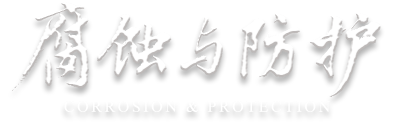


 下载:
下载:

